Notes from August 9, 2024 Meeting
This was our 87th meeting. We were able to celebrate the 13th anniversary of MASS meetings, our first meeting was on July 20, 2011. Some things never change, I think we talked about the Dragon and Starliner capsules that night too. Dean, Laura, Keith, Hank, Don, Harry and myself were in attendance. There are also a couple of NASA anniversaries around this time of year, on July 20 but in 1969 was the first moon landing (55 years ago) and on July 21 but in 2011, just a day after our first meeting, the Space Shuttle program came to an end with the landing of the STS-135 mission. We’ve been taking too long between meetings. It has been a long 20 long weeks since we met on March 22, 2024. Our new goal is to meet about every 2 months. We’ll see how we do.
Intro Items
I first had to show everyone my recent SLS rocket LEGO build. I assembled it around Father’s Day this year and really enjoyed the gift. It had 3600 pieces, 635 assembly steps and took 29 hours of build-time over 6 calendar days. Building with LEGO’s is a great way to get strong fingers.
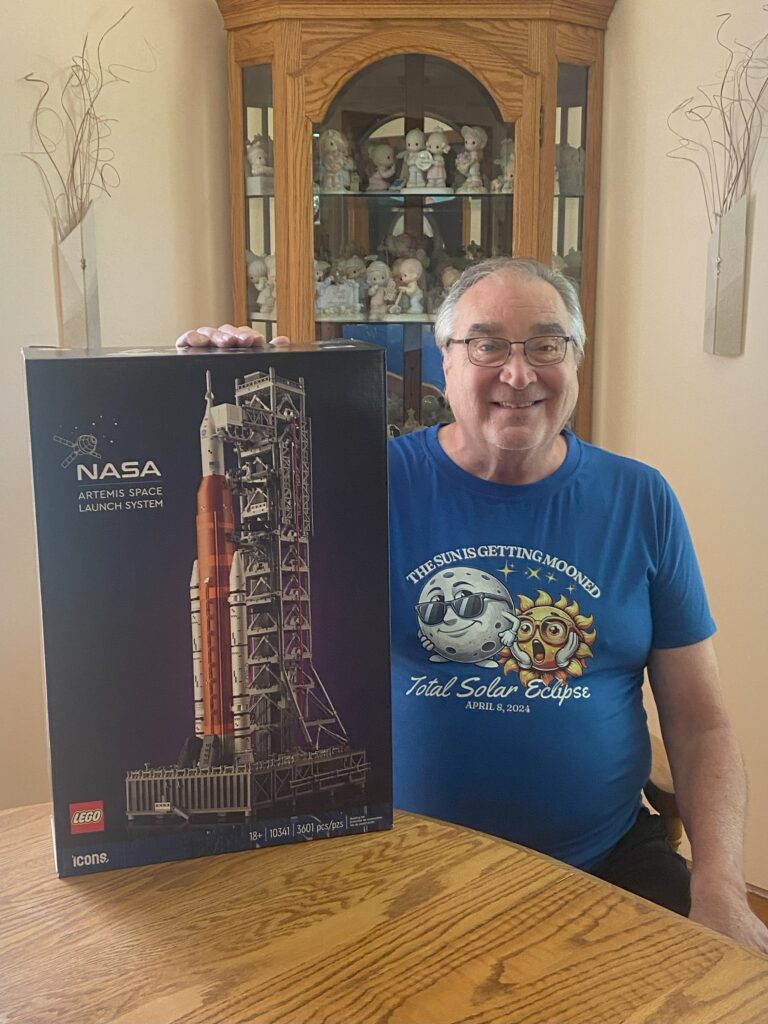
Next we reminisced about the last Astronomy Day at Harper College on May 18. Dean, Keith, Harry, Carol and I attended and we got to talk to Kevin Cole, who is one of the astronomy professors at the school. Kevin organizes the event. He is notable in that he is the one who suggested we call our group, the Midwest Astronomy & Space Society (MASS). At the event, Dean gave a presentation titled, “A Global Space Program”. He posited what humanity could accomplish in space if all the nations cooperated rather than competed. I think our current cooperation with Europe thru ESA and Japan thru JAXA are good examples of the benefits of cooperation. Our strained relations with Russia on the ISS sometimes has had as much negative as positive results, but they sure saved our space program when the Shuttle had issues or after it was retired. I’m not sure we will ever be able to cooperate with China with their state sponsored industrial theft and differing human rights perspective.
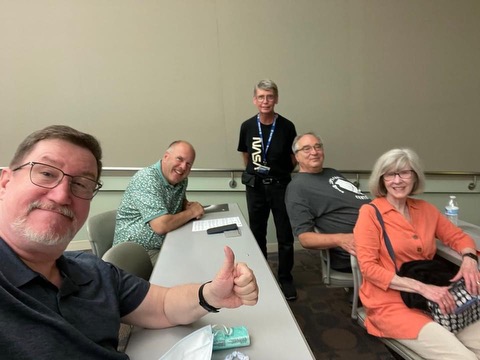
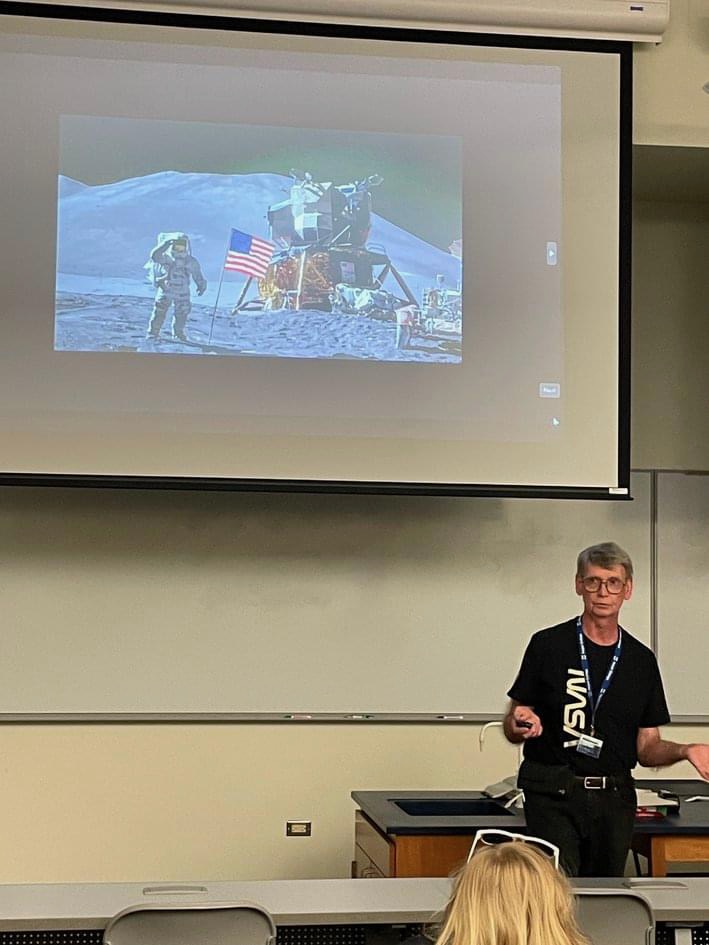
Carol, my older daughter, Jennifer, and I got to take a tour of Yerkes Observatory near Lake Geneva, Wisconsin. Jen was the prime mover behind getting the tickets and made it happen quickly. The observatory is only about 20 miles north of the state line and took about 1.5 hours to reach. The 2:30 PM tour lasted about 1.5 hours and cost $43 per person.

It was very entertaining with many stories about the history and personalities that the observatory had since 1895. The large telescope is a 40 inch diameter refracting telescope, the largest glass lens telescope ever successfully built.
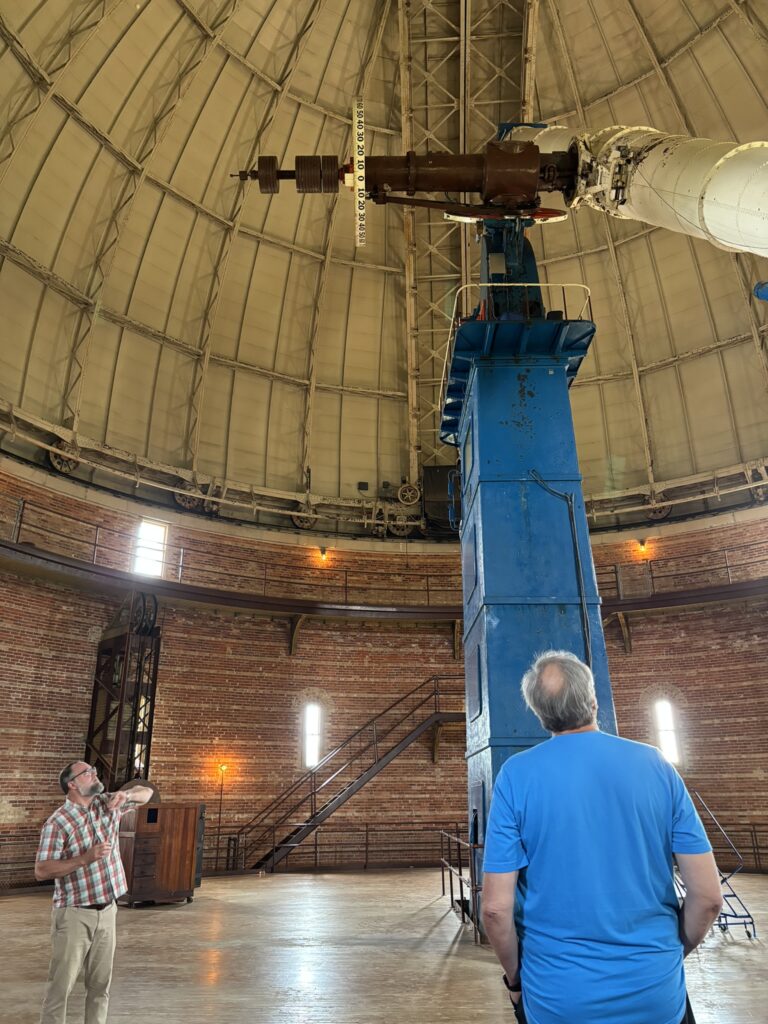
Refracting telescopes suffer from the weight of the glass lens being so heavy that the glass actually sags ruining the optical quality. The sagging occurs because the lens can only be supported on its outer rim. All subsequent larger diameter telescopes are mirror based. They benefit from the mirror being supported over its entire back area. The long length of the telescope tube also causes issues with the height of the viewing end above the floor. Yerkes solved that problem by having the entire floor of the observatory be an elevator that can travel 20 feet up or down. The remaining height adjustment for viewing through the eyepiece is made up with a rolling 20 foot staircase.
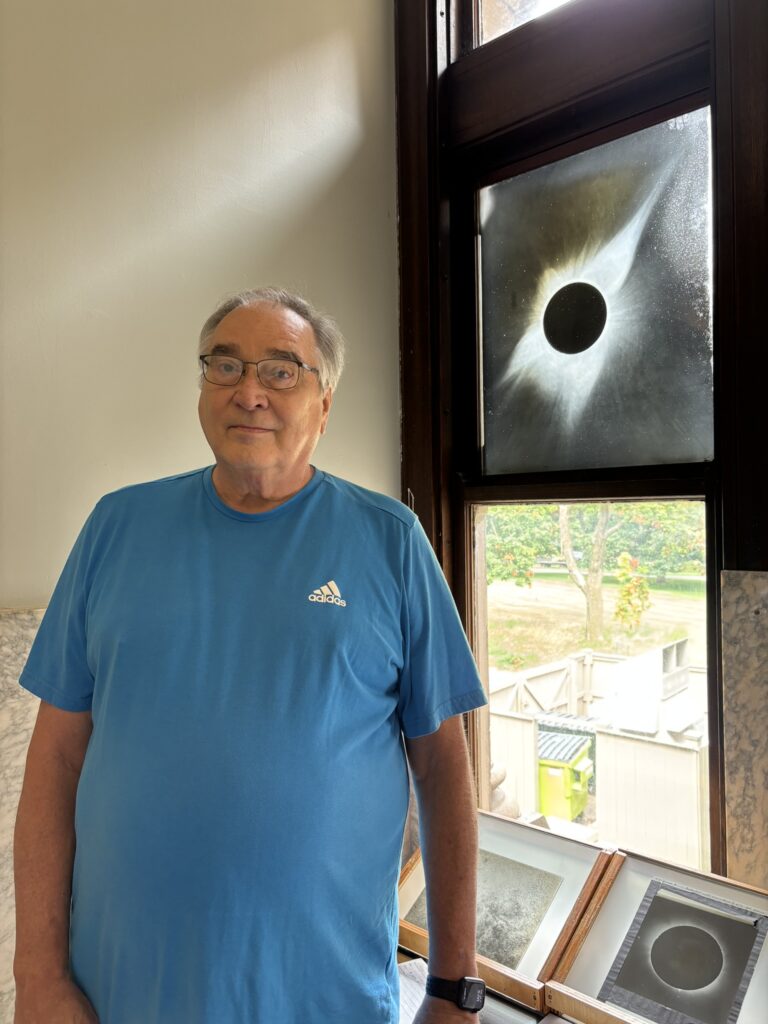
The University of Chicago ran the facility until 2018 and fortunately a local organization saved it and its grounds from becoming carved up into luxury lake-houses. They have so far invested $15 million in renovation getting the buildings acceptable for public tours. The 1895 architecture is amazing with carved pillars with images of Charles Yerkes (the guy who built the Chicago elevated train system) and John D. Rockefeller.
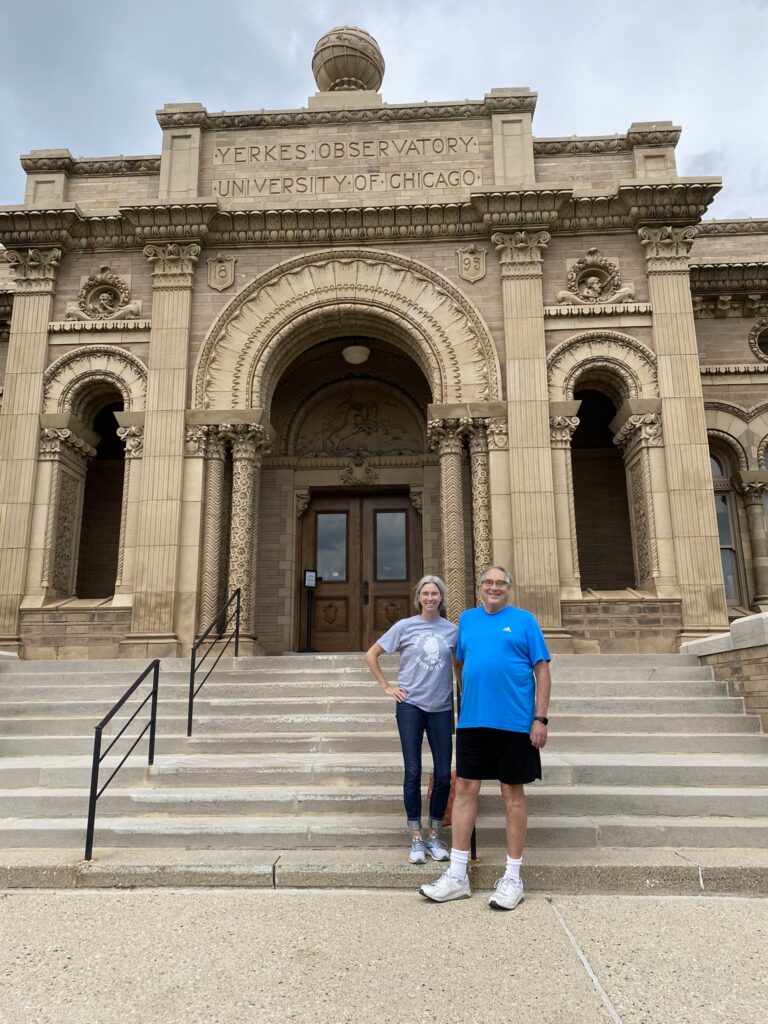
They must have had a pretty good sense of humor in the 1890’s because Yerkes is depicted with horns on his head and Rockefeller has an exaggerated big nose which originally had a bee on it. But when Rockefeller was scheduled for a tour, someone in charge at the observatory got cold feet and had all the bees chiseled off his images.
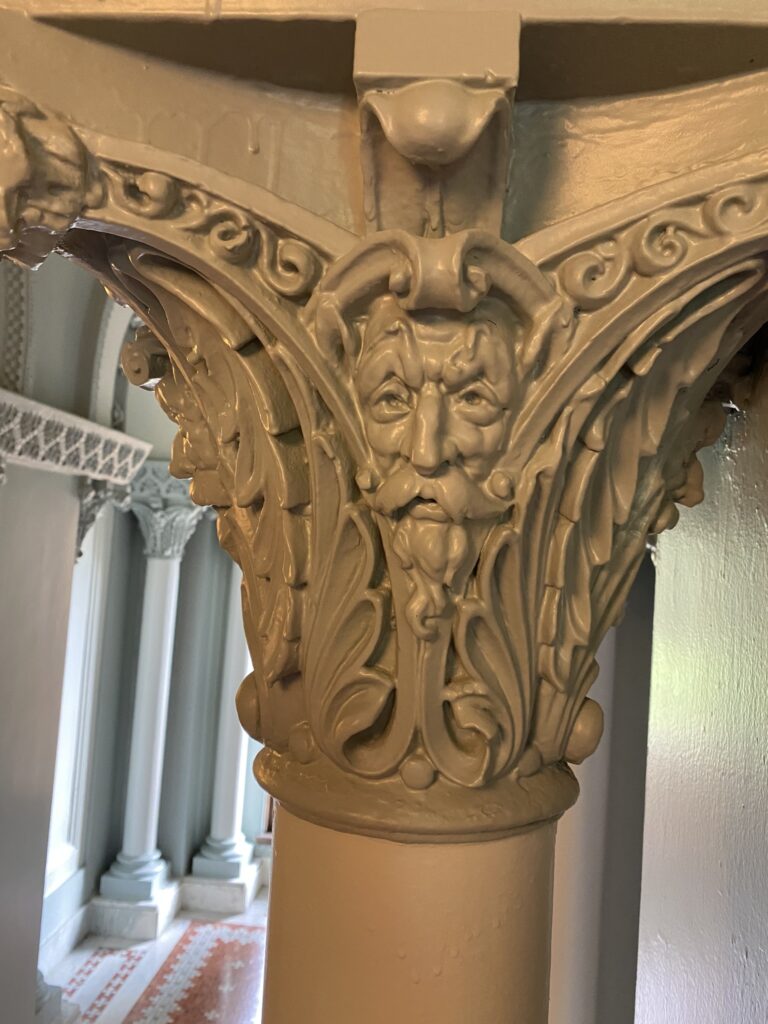
There is an incredibly long list of famous astronomers and astrophysicists that have been there including Albert Einstein, Edwin Hubble, Vera Rubin, Subrahmanyan Chandrasekhar, and many others including our own Dean who did some of his research there.

Carol, Jen and I got to eat dinner at a restaurant only a few miles away at the Lake Lawn Lodge. I remember being there as a budding engineer for ComEd over 40 years ago and demoing a new mini-computer called SyFA (SYstem For Access) that was developed in South Africa and going to be installed in all of Edison’s power plants. I can’t believe I was that close to Yerkes and didn’t try to take a tour of it.
I announced that Joe DalSanto, astronomer at COD, is going to have a presentation titled “The Stars: Their Birth, Life and Death” on October 19 at 7:30 PM. His presentations are always good.
I then told the group that I’ve gone down the Internet rabbit hole called YouTube and first up is the most recent weekly video by Fraser Cain called “Space Bites” which is always an interesting summary of what has happened in astronomy and space. I promised that we would be frequently pause during the video to either elaborate on a subject or discuss any questions about it. Here is Space Bites from 8/3/2024.
Topics in the video are:
- Scientists think they know why the DART mission impact of the Didymos (moon) of the asteroid Dimorphos was so efficient in shortening the orbital period. Fraser said we have finally avenged the dinosaurs and punched an asteroid in the nose for wiping them out 65 million years ago. It show how Dimorphos spin up as it accumulated material and eventually flung off boulders that coalesced into Didymos. This sort of reminds me of the most popular theory for how the Earth’s moon formed. Astronomers think that it coalesced from material thrown out after Earth got hit by a Mars-sized planetoid. With Didymos coming from all those loose rocks, scientists believe its surface would be like walking on one of those ball pits where you would just sink down.
- The source of “dark oxygen” in the depths of the ocean comes from metallic nodules acting like batteries and breaking the water into its elemental gases. This seems like a good discovery that would increase the likelihood of life on watery exoplanets.
- The astronomer Kepler used a pin-hole device to observe sunspots without using a telescope 140 years before others started keeping track of them. His observations would go back to cycle -13 (a sunspot cycle takes about 11 years). The historical sunspot counts started around 1749 with cycle 0. We are currently approaching the sunspot maximum for cycle 25 this year. Here is the historical sunspot number site. Our current cycle reached nearly 200 sunspots in July exceeding the shaded estimate but in recent history the sunspot number reached 360 when we were launching Sputnik in October of 1957. Kepler’s observations pre-date the 1749 historical date by 143 years (13 x 11 year cycle).
- Boeing’s Starliner capsule is experiencing problems with thrusters and helium leaks.
- SpaceX had a failure in the second stage of its Falcon 9 rocket and lost a set of Starlink satellites to atmospheric drag.
- Your might only have to go down a few millimeters of water ice to be protected yourself from the enormous radiation on Jupiter’s moon Europa. Water is an excellent blocker of radiation. Astronauts on the ISS frequently go into the section of the space space where there are water bags on the walls of the station during high radiation events.
- SpaceX performed a static fire of the Starship rocket that will be launched as early as September on their 5th test of the rocket.
- The Japanese released photos of their experimental satellite researching how to remove debris from Earth orbit. The satellite is observing one of their own spent upper stage rockets. Space debris removal is a sensitive subject because the technology could be used to remove functioning military satellites from enemy countries too.
Starliner
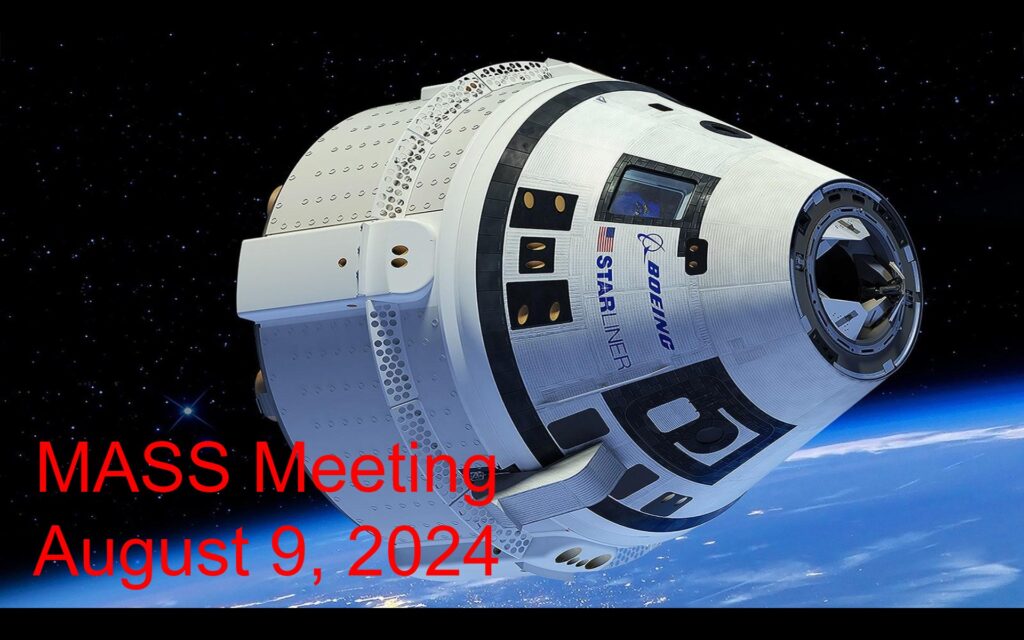
I didn’t think this would be our main topic, but Starliner’s problems continue to haunt NASA. What was to be an 8 day mission to the ISS is now experiencing day 65 with no definite end in sight. In fact, NASA plans to decide by mid August whether Butch Wilmore and Sunita Williams will come down on the Starliner or stay 8 months on ISS and return on the CREW9 Dragon scheduled to launch September 24. Dragon would launch with only 2 people rather than the planned 4 if the Boeing astronauts need a rescue. I took a vote of the group as to which plan NASA would choose. I was surprised that I was the only one who thought NASA would return them on Starliner. Dean, Keith, Hank, Don and Harry all thought they will be coming down on Dragon. We did a deep dive on the issue with this video from Ad Astra.
Historically Boeing has had a lot of problems with Starliner. Back in 2011, Boeing got $4.2 billion to develop Starliner and SpaceX got only $2.6 billion to develop crewed Dragon. NASA thought Boeing would be the sure bet to get a manned capsule ready on time and on budget. Things couldn’t have gone much different. SpaceX launched their test manned DM-2 mission on May 30, 2020 with Doug Hurley and Bob Behnken. Since then they had put 50 people into space with 8 operational missions to ISS with 4 people each and 3 private Axiom missions to the ISS, plus an extra private mission that didn’t dock to ISS headed by Jared Issacman called Inspiration 4.
Meanwhile, Boeing launched Starliner on its first uncrewed test in December 2019 but bad software prevented it from docking with ISS. Then bad corroded valves prevented the capsule from being launched. Finally, on May 19, 2022 Starliner launched on a redo of the uncrewed test mission, successfully docked to ISS and returned to Earth. But then it was found that Boeing needed to remove miles of flammable tape that wrapped much of its wiring and that their parachutes didn’t have the necessary margin. After considerable delay, Starliner finally launched with crew on June 5, 2024 even though they had helium leak issues. On approach to ISS, 6 thrusts were disabled by the software due to low thrust from over heating and the helium leak arouse in 5 more locations. NASA and Boeing have used the extra time on orbit to both test the thrusters on Starliner (5 of the 6 thrusters passed the test) and on the ground where similar thrusters were put thru a test 5 times more rigorous than what Starliner needs to return to Earth. But some NASA officials feel that Starliner might be exceeding the 1 in 270 loss of crew specification for Starliner’s return.
The ISS has only 2 ports compatible with Dragon and Starliner. One is taken by Starliner and the other with the CREW8 Dragon. Starliner must undock from ISS for CREW9 Dragon to dock to ISS. But now we hear that Starliner’s software is configured for manned intervention as the backup to automated problems and that Starliner can’t return to Earth without crew unless a complicated software update is performed. I’d hate to be the person in charge of scheduling spacecraft dockings on the ISS.
NASA has announced that Boeing’s first operational Starliner mission has been delayed from Spring to Fall 2025. Boeing’s contract with NASA is for 6 operational missions. NASA plans for 1 Boeing and 1 SpaceX mission per year after Starliner is certified. With the ISS expected to last only to 2031, there isn’t a lot of wiggle room for Starliner to accomplish its missions. Boeing has already lost a couple of billion on Starliner development. I’m not sure what their decision would be if NASA says they have to fly another test crewed mission before they can be certified.
SpaceX still plans to perform the Polaris Dawn mission with Jared Issacman, Scott Poteet and 2 SpaceX women in a Dragon capsule on a 5 day non-ISS docking mission launching on August 26. Jared plans to perform a tethered EVA from the capsule using a new SpaceX spacesuit. The other 3 persons in the capsule will also need to wear special spacesuits because Dragon has no airlock, so the entire capsule needs to be at vacuum. Polaris Dawn also plans to achieve the highest orbit since Apollo missions with an 870 mile high orbit.
SpaceX
The Falcon9 rocket 2nd stage had an oxygen line leak caused by vibration fatigue on July 11 with the Starlink 9-3 mission. The leak caused the re-light of 2nd stage to fail putting the 23 Starlink satellites into a too low orbit. The satellites were lost when atmospheric drag was too intense to be overcome with their xenon thrusters. As a solution, SpaceX decided to take the pressure sensor off on future second stages. There was a 15 day grounding of the Falcon 9 while the FAA reviewed the issue. SpaceX followed up with 3 Starlink launches in 28 hours of getting the green light to resume launches. And then, 2 more launches with another Starlink launch and a Cygnus resupply mission for Northrup Grumman. As of meeting date, SpaceX has launched Falcon 9 73 times this year. Add 1 Falcon Heavy and 2 Starship launches to get a total of 76 launches so far in 2024.
On June 6, SpaceX launched its new StarShip rocket for the 4th time (IFT4). Both stages landed softly in the ocean, the Super Heavy booster in the Gulf of Mexico and the StarShip upper stage in the Indian Ocean. SpaceX plans to launch the Starship IFT5 mission in September and it might include a catch attempt by the “chop-sticks” at the Boca Chica, Texas site. SpaceX has built a second launch pad at Boca Chica, so hopefully they won’t destroy their Texas infrastructure.
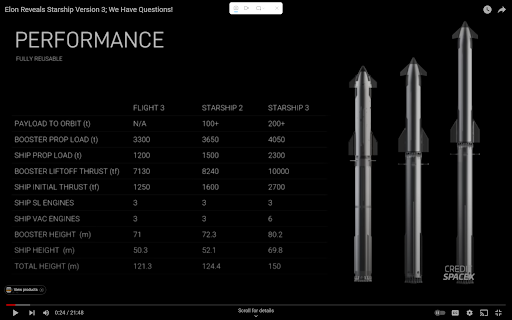
SpaceX revealed that they are planning 2 more revisions to StarShip. They will stretch both the Starship and the Super Heavy. Starship will be upgraded with 3 more vacuum Raptor engines bringing its total to 9 engines. The propellant mass of Super Heavy will be increased from 3000 mt to 4050 mt and StarShips propellant will go from 1200 mt to 2300 mt. That is a lot of liquid methane and oxygen.
The “Dear Moon” mission has been cancelled by the Japanese billionaire, Yusaku Maezawa. I guess when he bought a ride on Russia’s Soyuz capsule up to the ISS, much of his desire for space went into that mission. The Dear Moon was to be a trip on SpaceX’s Starship with a crew of 9 artists and other non-traditional astronauts including, the Everyday Astronaut, Tim Dodd, but Starship is far from being manned rated and many years delayed from the original planned time seemed to be his reason to cancel.
SpaceX has been awarded an $843 million contract to deorbit the ISS in the 2031 timeframe. De-orbit was to be 3 Russian Progress capsules but our relationship with them is a little strained now. The modified Dragon vehicle would dock to Node2 forward port of ISS. It is to be launched on an undetermined rocket. ISS would drift down for a year or so to a 220 km high orbit. The modified Dragon with a much larger trunk section 2 times its current size would have 46 Draco motors with 30 of them on the back end of the trunk. 22-26 of the engines would fire at the same time to perform the deorbit. The vehicle would launch about 18 months before deorbit, a new ISS crew would launch about that time and leave the ISS about 6 months before the deorbit. There would be 10 or 11 6 month rotational crews on ISS after CREW9 launching this coming September. If the deorbit is scheduled for Jan 2031, launch would occur in July 2029. The last crew would depart in July 2030. The proposed vehicle has 6 times Dragon’s typical fuel (16 mt of prop) and total weight of 30 mt. It also has 3-4 times the thrust of the current Dragon or 10,000 newtons (4.5 newtons = 1 lb of thrust). It would take about 4 days to accomplish the deorbit and Dragon must be able to handle it without communication or power from ISS because it may be lost as ISS feels the effects of a lower orbit. Currently ISS has a mass of 400,000 kg (400 mt) or 900,000 lbs.
NASA is hoping that ISS capabilites will be transferred to a future commercial space station. And is funding several companies for this to occur. Scott Manley did a nice job summarizing them. They include: 1) Axiom Space; 2) VAST; 3) StarLab; and 4) Orbital Reef from our buddy, Jeff Bezos. Orbital Reef looks like the most ambitious with DreamChaser and Starliner docking to it. We also have Gateway coming from NASA. This space station will be in orbit around the moon in support of the Artemis program. There is also the Chinese, Tiangong station which the Russians cannot launch to because it is in a too low inclination orbit. Scott’s video also mentions the Dragon deorbit vehicle and shows great footage of the IFT4 flight of Starship with the Super Heavy landing in the Gulf of Mexico.
Elon Musk is losing a little of his shine in my eyes ever since his take over of Twitter. His latest antics include giving $45 million/month to the Republicans because they picked JD Vance as their Vice-President candidate. Vance thinks that childless couples are practically worthless and shouldn’t have full voting privileges. Musk also is moving his SpaceX corporate headquarters from California to Texas because of a law enacted in California about LGBQ issues. I know there is probably a lot of rich people trying to sway the election, but Musk seems to be the most blatant in doing it publicly.
NASA
Is defunding the Chandra x-ray Telescope without any replacement capability. Scientists are fighting the money maneuver but I’m unsure if they will be successful.
NASA is also cancelling the VIPER moon rover. It is part of the CLPS program. VIPER was canceled due to cost but the Sentinel new ballistic missile system is getting $140 billion to build new silos across the US. VIPER exceeded its budget by 30% which is against a law according to Congress, so NASA has no choice but to plan to disassemble it and then pay the cost to fly a CLPS mission with a mass simulator of concrete. What a dumb decision!! VIPER’s cancellation with already $450 million already spent, seems doubly bad. I’m getting more pessimistic whether the US will beat China in getting people back to the moon.
NASA CHAPEA Mars simulation ended July 7. The link has an interesting 1 minute video showing how the mission habitat was 3D printed. The mission had a crew of 4 and lasted 378 days. They spent the time in Houston in a 1700 sq ft 3D printed habitat. There was an eclectic volunteer crew that was subjected to things like a 20 minute delay on communications with mission control and contact with family. I’m not sure I could spent over a year under those conditions. I had hoped that Beth would have joined us to give her perspective since she has participated in space simulation missions in Hawaii and Poland.
Astronomy
The James Webb Space Telescope (JWST) just celebrated its second year of operation. I still clearly remember its launch on Christmas Day in 2021 on an Arianne 5 rocket from French Guiana. Fraser Cain did a nice summary of the second year discoveries. And Ad Astra discussed the 7 best photos from JWST in its second year.
There is a potential nova coming to the sky. Startalk with Neil DeGrasse Tyson has a good video describing the event. The star about to go nova is named T Corona Borealis and is an 80 year re-occurring nova 2600 light years away. It should reach magnitude 2.5 before the end of the year and be about the same brightness as the North Star, Polaris. To be a supernova, the white dwarf has to be over 1.4 times the mass of the Sun and we don’t think this star is that massive. If you need help finding Corona Borealis this might help.
Mars
Our Mars rovers turned up two interesting rocks recently.
The one most consequential for past life on Mars is the Perseverance rover “leopard spots” rock. The rover took a sample of the Cheyava Falls rock (a waterfall in Grand Canyon). Analysis said it contains organics, but organics can come from geological processes as well as biological ones. The red part of the rock is hematite, an oxidized iron rich mineral, but there are also 1 millimeter across dark rings of oxidized iron, with inner parts being a tan color less oxidized mineral. Reduction spots like that can come from microbes. Green olivine crystals embedded in the rock hint at a non-water-based origin but the crystals could have come later. Mars Guy had a short video describing the rock.
The other rock was a chance discovery by the other Mars rover, Curiosity. The rover drove over the rock and crushed it, only to discover that it was pure sulphur. These brimstone rocks can burn in Earth’s atmosphere and were mentioned in biblical times. Mars Guy also spoke of these.
The sample from the “leopard spot” rock that Perseverance cached in its sample container makes for an even more compelling case for the need to bring these samples back to Earth. Laboratory equipment the size of a room is necessary to analyze the sample to determine if it was biology or geology that formed the ringed spots. The MSR (Mars Sample Return) plan was for NASA and ESA to launch around 2028 a lander to retrieve the sample from the surface of Mars, put the sample into a rocket and then blast it into orbit around Mars where it would rendezvous with a Mars orbiter that would then fire the samples back to Earth. But the schedule for MSR was going to slip to the 2040 timeframe or require an infusion of money that would expand the budget to $8-13 billion. On April 15, 2024, NASA went back to the drawing board and asked industry and academia for something quicker and cheaper. Maybe the “leopard spots” Cheyava Falls rock will make for a stronger case to justify the cost of the Mars sample return mission.
We took the full 3 hours to get through the above topics and expressed a desire to meet more frequently, like every couple of months. Hopefully you’ll see new meeting notes in October.
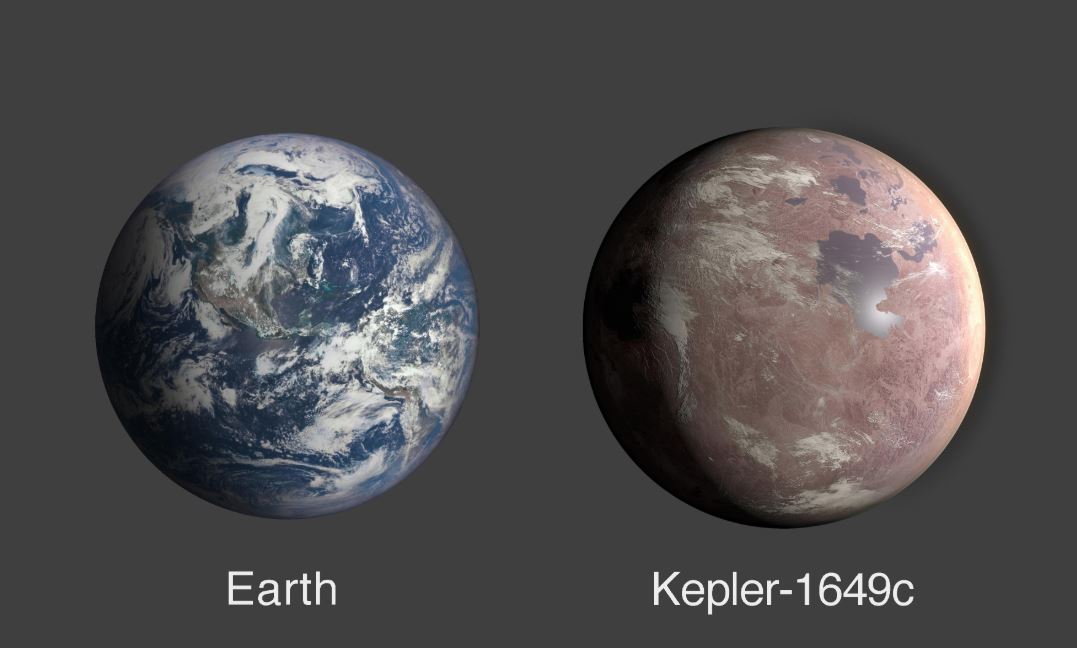
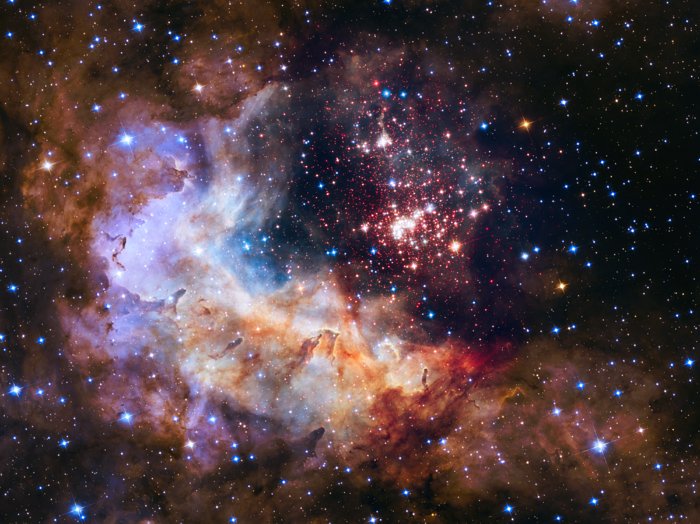
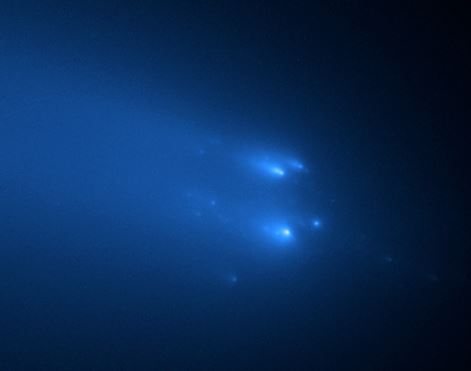
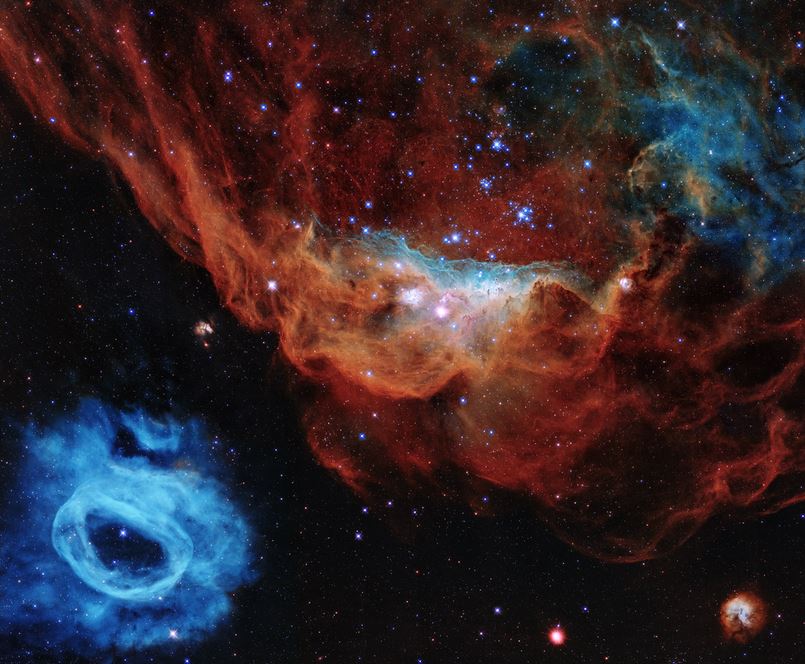

One Response
Another wonderful and insightful read, Jim! Thanks again for putting this together. You captured so much and should be writing for Ad Adstra or Scientifc American, by far.
Thanks again!
-Keith
Comments are closed.